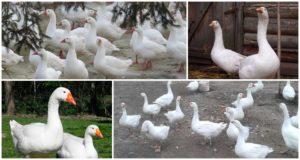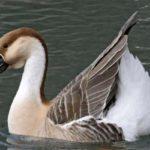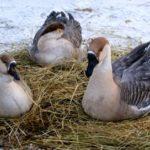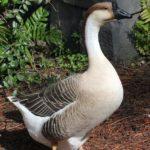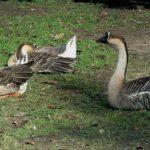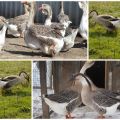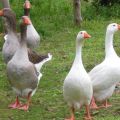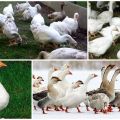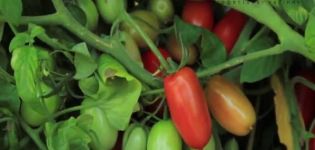Description and characteristics of Chinese geese, the rules for their maintenance
The Chinese breed of geese is distinguished by its original exterior. They have a large bump on their beak near their forehead. The "Chinese" have a relatively small body weight. Adult males weigh only 5.45 kg. "Chinese" are bred by lovers of exotic birds. The Chinese breed takes root well in any poultry yard. True, the "Chinese" have an aggressive character. It is better to keep them in a separate enclosure.
History of origin
Chinese geese, as the name implies, come from China. The ancestors of these birds were wild dry beetles living in distant Manchuria and Siberia. Chinese geese came to Europe and Russia in the 18th century. This breed was crossed with native species to improve productivity. The "Chinese" were used for breeding the Kuban, Kholmogorsk, Pereyaslavl, Gorky varieties.
Description of the Chinese breed
"Chinese" are white and brown. Birds have a "swan" - a long and beautifully curved neck, flattened head. The most important feature is that there is a growth in the form of a large bump on the forehead at the base of the beak. The white "Chinese" have snow-white plumage, a beak of a rich orange hue, paws are dirty red. In brown birds, feathers are brown, white and gray, and a dark stripe is visible on the back of the head and neck. The beak of the variegated geese is black, and the legs are dull orange.
Vices
The main defects of the Chinese goose breed, leading to the culling of birds:
- short or thick neck;
- small underdeveloped bump;
- a very sagging leathery fold under the beak.
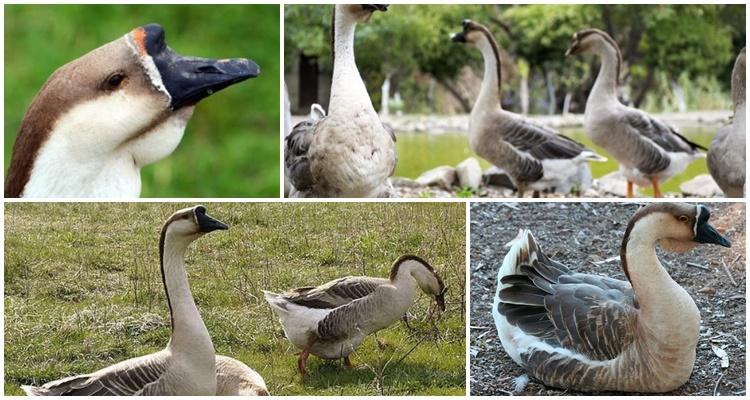
Subspecies
Varieties of Chinese geese:
- White. The white "Chinese" have snow-white plumage and a bright orange beak with a large cone. Geese have good immunity, a high survival rate of young animals. The disadvantage of this subspecies is aggressive behavior during the mating season and during the rearing of chicks.
- Brown. The brown "Chinese" have motley plumage of brown, white and gray. There is a dark stripe on the back of the head and neck. The beak and bump are black.
Specifications
Main characteristics of Chinese geese:
- birds are bred for delicious meat;
- adult males weigh 5.35 kg, females 4.35 kg;
- start rushing at 9 months;
- 80 eggs are laid per year;
- the average egg weight is 141 grams;
- at two months of age, goslings weigh 2 kg;
- in comparison with other goose breeds, the "Chinese" have a small weight;
- incubation instinct is poorly developed;
- birds have an aggressive character;
- the survival rate of young animals is over 80 percent.
How to properly maintain and care for birds
To keep and breed Chinese geese, you need a poultry house, a walking area and a nearby pond. The "Chinese" have an aggressive character. It is better to keep geese separately from other inhabitants of the poultry yard.
In summer, throughout the day, birds can graze in the meadow, nibble the grass, and swim in the pond. Geese should spend the night in the poultry house. Recommended area - 1 sq. meter per bird. A straw bedding is laid on the floor. Low boxes or baskets are used for nests. They are also lined with straw. There should be green grass on the walking area, there should be a feeder and a drinker nearby. Birds should have access to limestone and sand all year round.
In winter, during cold weather, geese should be kept indoors. Birds are not afraid of frost, but it is advisable not to let them go outside in a severe cold. Paws may freeze on ice. In the poultry house, the air temperature must be at least +15 degrees Celsius.
Birds must be kept clean. It is recommended to change the litter as it gets dirty. The remains of the food must be taken out of the trough so that nothing sour and moldy. Chinese geese are always given clean water, it is changed daily.
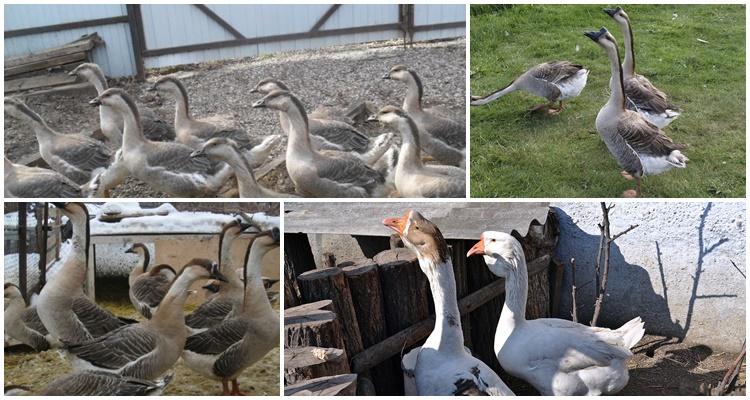
How to feed the breed?
Little goslings are given a crushed egg, cottage cheese, yogurt. Young animals are fed with starting compound feed, finely chopped vegetables. Young birds are given a grass cut, plants (clover, plantain, dandelions).
Adult geese are fed with crushed grain, meal, cake, bran, boiled potatoes, wet mash. In the diet of birds, finely chopped carrots, fodder (white) beets, pumpkin must be present. In winter, spruce branches can be given to geese. An adult bird drinks at least 2 liters of water per day. All year round, the "Chinese" are given salt, chalk, bone and fish meal. In winter, pharmacy vitamins are added to drinking water.
They feed the "Chinese" 2-3 times a day. In the morning they are given damp mash, in the afternoon - finely chopped vegetables or grass cut, in the evening - grain mixtures. Drinking bowls must be placed near the feeders into which the food is poured. Geese should drink water while eating.
Subtleties of reproduction
Chinese geese can be crossed with each other or with large meat goose breeds (Kholmogory, Toulouse). From 9-10 months of age, geese lay eggs. True, females rarely sit on the clutch. If this happens, then the birds are equipped with warm nests in a quiet corner of the house. A feeder with grain and a drinker are placed near the hen. If the female leaves the nest for more than 20 minutes, she is forcibly returned back. The goslings hatch after a month. Chicks are left with the goose or placed in a separate enclosure.
Chinese goslings can be bred using an incubator. Fresh eggs are taken for incubation. For a month in the incubator, the temperature is maintained at 37.8-38 degrees Celsius. Eggs are turned once a week. When the chicks are born, they are transferred to a room in which the air temperature is maintained at 30 degrees Celsius.
Immediately after birth, goslings are fed with chopped boiled eggs, cottage cheese, yogurt. Over time, the temperature of the content is lowered. Green onions and herbs are introduced into the diet of birds. On the 10th day of life, goslings can be fed with starter compound feed, finely chopped vegetables, wet mash.
Diseases and their treatment
Disease resistance in Chinese geese depends on the diet and conditions of detention. If the "Chinese" are well fed and kept clean, they will not get sick.At the first signs of infectious diseases (diarrhea, inactivity, discharge from the eyes, nose), an antibiotic for birds is added to the water for geese (you can buy it at a veterinary pharmacy). After treatment with antibacterial agents, the "Chinese" are given probiotics. For prophylaxis, it is recommended to give goslings vaccines in the first days of life. For the treatment of helminthic diseases, birds are prescribed antiparasitic drugs.
